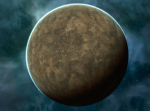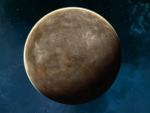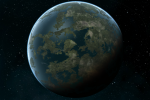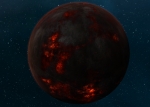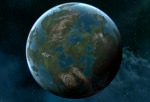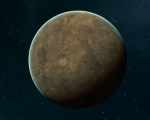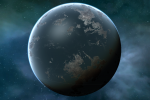Origin
Origin (J120442) is a system in class 2 Wormhole space. The system is currently home to the Alexylva Paradox Corporation and is in the process of being settled and colonized.
| Stellar Primary | K3 (Yellow Small) |
| Planets | 9 |
| System Class | 2 |
| System Locus | J120442 |
| System Status | Occupied |
| Population | 3,129,000 |
History
Origin was originally colonized by Far Eastern WH, an exploratory corporation that occupied the system and placed slave colonies on the surface of all nine of the planetary bodies in system. The system was held with the aid of the Amarr Militia, who maintained a capital presence in the system in the form of a Revelation Dreadnaught. Far Eastern WH was evicted in July YC115 by Anomalous Existence, Alexylva Paradox, and Re-Awakened Technologies. Alexylva Paradox would go on to lay claim to the system and liberate the colonies. In December of YC115, the Alexylva Paradox would found its own permanent colony in Origin, and state their desire to form a lasting civilisation within the system.
Celestial Bodies
The system of Origin has one star, nine planets, twelve moons, and two static wormholes.
Isis
Isis is the stellar primary of Origin, a K3 Yellow Small type star. The common yellow dwarf is unremarkable in many ways, it is five billion years old, and is expected to shine for another 3.9 billion years. Isis experiences a solar cycle of 18 years, estimated off of current data. Its habitation belt exists between 2 and 4 AUs, although terrestrial worlds exist outside the belt due to atmospheric processes local to those worlds.
Perihelion
Perihelion is the first planet in Origin, a sun scorched ball of iron orbiting only 0.5 AUs from Isis. The planet is covered in mountainous tectonic features formed as a result of the intense heat the planet experiences from its host star. Despite its small size, with a diameter of only 6,937 kilometres, Perihelion is dense. The small world is composed almost entirely of iron. The core of the world is an ocean of liquid iron on which a rocky crust rides. Volcanic eruptions occur every few months on Perihelion, creating mountain ranges of heavy metals. Perihelion lacks a persistent atmosphere, though it often sports a temporary one. Despite the volcanic activity releasing large quantities of sulphur, methane, carbon dioxide, and other gasses, Perihelion's proximity to Isis ensures the vast majority of its atmosphere is quickly lost to space, blown away on the solar winds. The remaining atmospheric gasses cling to the lowland areas, and even there, the atmosphere is less then .1% the density of Renaissance.
Gypsy
Gypsy is a airless ball of dead rock orbiting 1 AU from Isis. At only 9,488 kilometres in diameter, the small world is long dead. The atmosphere of Gypsy is only 1% as dense Renaissance, and composed mostly of carbon dioxide and nitrogen. The planet has no tectonic activity, and its likely that it has not for at least a billion years. The geologic features have been smoothed by the faint wind, over the course of eons, and most of the surface land features have been eroded and covered over by seas of dust and sand. What surface features emerge are highly oxidized, giving the world a vivid contrast between the dull red rock, and the paler silicate sands. There is a possibility that Gypsy may have once contained liquid water on its surface, but that water, if it ever existed, was likely lost to space as the planet's core cooled, and its magnetic field failed. Today, Gypsy is mostly overlooked as a colonization prospect. The 48,000 people who call Gypsy home are all there on industrial contracts, harvesting valuable metals and minerals. There are no current plans to develop permanent habitation on Gypsy.
Eureka
1.6 AUs out from Isis, floats Eureka, and its single moon, Archimedes. Eureka is a young world, wreathed in oceans of cooling magma and sulphurous gases. Eureka is a fairly large world at 18,366 kilometres across, and its hot, the surface is a blistering 820 C, precluding the formation of liquid water. Eureka is aflame in constant volcanism, with several active supervolcanoes releasing cubic kilometres of material each year. The atmosphere of Eureka consists mostly of sulphur and carbon dioxide, and is almost thirty times denser then that of Renaissance. Oceans of liquid rock pour out across the surface, and frequent pyroclastic outbursts blast volcanic ash high into the atmosphere, turning the sun a dusky red even at midday, and it is frequently obscured entirely for months at a time, clouded over by ash and sulphur dioxide. Despite its hostility, the planet is coveted for its abundant metal and crystal in easily accessible surface deposits. The world is the site of several industrial colonies, and hosts a population of 21,000 hearty souls.
Arboria
At 2.6 AUs, the jungle world of Arboria is the innermost of the temperate worlds of Origin. Its diameter is 13,524 kilometres, and its mass gives it slightly higher surface gravity then Renaissance, as well as an atmosphere twice as dense. The world boasts an active tectonic system, and its core is likely a spinning dynamo of iron, given that it is protected by an electromagnetic field. These conditions give rise to surface water, and to life. Arboria is a world of life, practically 95% of surface land on Arboria is wrapped in thick dense rainforest. There are no deserts, no tundras, and few plains. The world is almost entirely vegetated. This is accomplished by virtue of the planet's dense water vapour rich atmosphere. Storms are frequent, and it rains nearly constantly in some areas. Verdant river valleys cut long fingers into the dark jungle, and mist and steam are constantly rising out of the humid forests, adding moisture back into the air to begin the cycle again. Arboria is hot, but it is within the upper ranges of human tolerance. The daytime temperatures of 45 C can frequently be dangerous due to the density of the air however, and most inhabitants of the world only go outside at night, when the temperatures fall to a more tolerable 25 C. More dangerous then the temperature though, is the wildlife. Arboria features an impressive ecosystem, with creatures of every scale occupying any available ecological niches. The effect of this is that there are a lot of large predators to which a human is seen as a decent meal. The fact that our biologies and those of the planet are compatible does not help this matter. Having never encountered humans before, the wildlife is often not afraid of us, and this has caused major issues within the settlement. These though are thought to be minor setbacks in the colonisation of Arboria. The world already hosts a population of 245,388 colonists, freed slaves, and scientists studying the planet. The colonies though are fairly constrained by the dangerous wildlife, and most of the population is forced to live within fenced in regions that have been cleared of predators.
Crucifix
Only .1 AUs beyond the orbit of Arboria lies its dark twin Crucifix, and her two moons, Ghost and Shade. At 2.7 AUs, Arboria and Crucifix sometimes come so close to each others orbits as to begin effecting weather conditions. If Crucifix had any weather conditions to effect. With a diameter of 12,586 kilometres, and similar mineral compositions to Arboria, geologic evidence suggests that Crucifix may have once been temperate and habitable, before some catastrophe befell the world. Today Crucifix is blackened and bruised with lakes of magma, basalt flows, and colossal impact craters. The two moons orbit Crucifix in an imbalanced pirouette that will eventually see one or both of them thrown either into the planet or across the system. It is likely that at some time in the relatively recent past, Crucifix suffered a collision with another stellar body of at least 1/3 its mass. The impact would have created a cloud of debris that rained out over millions of years, preventing the world from becoming habitable again. This debris has since fallen out of orbit, and Crucifix has slowly began to cool once more, though it could be thousands of years before the planet once again supports oceans. The atmosphere of Crucifix consists of nitrogen, carbon dioxide, sulphur dioxide, oxygen, and methane, with trace amounts of ammonia, phosphorus, and argon. This atmosphere is twice as dense as Renaissance, and hot, varying across areas between 30 C and 120 C. Humans can go out onto some areas of the surface without protective clothing, but gas masks are required everywhere due to the toxic gasses in the air. Water has been found to occasionally collect in shallow surface deposits in cooler areas, and hopes are high that this world may one day harbour life, though the best estimates for a comfortable climate are thousands of years away. Crucifix supports a population of 112,000 people beneath protected habitats, mostly consisting of industrial workers, planetary scientists, and former members of the now defunct Akheteru Institute of Theology.
Renaissance
Orbiting at 3.7 AUs, Renaissance has been called the Jewel of Origin. Its diameter of 11,427 kilometres, gives it a comfortable .89 G of surface gravity. A Matar-type atmosphere of nitrogen, oxygen, and carbon dioxide is comfortable and breathable. Surface temperatures between -10 C and 35 C are mild, giving rise to vast salt water oceans, freshwater lakes, rivers, and life. The verdant world is covered in tall forests, many of its trees reach nearly a half a kilometre in height at maturity, and the forests are home to vibrant ecosystems and many plants and animals edible to humans. Grasslands occupy much the rest of the land area, with only a small amount being given over to deserts. Renaissance lacks icecaps, and its climate is mild year round. Plants continue to grow even in the winter, and snow is rare outside of high elevations. Geologically, Renaissance is stable, despite being tectonically active, volcanoes and earthquakes are rare, occuring mostly out at sea, though this does create a Tsunami risk in some coastal settlements. The most impressive geologic features of Origin are the mountains. Several mountain ranges on Renaissance rise above the atmosphere, reaching out into space. The areas between these mountain peaks are often deserts, with small pockets of atmosphere trapped between the mountains, unable to receive moisture. Hosting a permanent population of 1,387,000 people, Renaissance has been designated the capital planet of Origin. The first true city in system, Foundation, began being constructed in December of YC115 on the surface. The inner districts of Foundation are nearly complete, with power production, mass transit, schools, hospitals, and administration buildings already constructed. Beyond the inner districts, a massive construction boom is ongoing, as apartments, malls, parks, and businesses are built all the time. The population of Foundation alone is expected to reach two million by the end of the year, as more and more colonists come to the system. The planetwide population has been projected to reach 10 billion before the end of the decade. The two moons of Renaissance, Apophenia and Synesthesia, house the trunk routers for the system intranet bands, and The moon-planet system is a constant buzz of activity.Synesthesia has also been chosen as the home of the deep space listening array, possibly the first large scale radio telescope to be constructed in Anoikis.
Eidolon
4.8 AUs from Isis, lies the dead terrestrial world of Eidolon, and its three small moons, Sky, Feather, and Wisp. The cratered world of Eidolon is in many ways a mirror to Renaissance. While being another hive of intrasystem activity, the 324,000 strong population of Eidolon lives exclusively under atmospheric domes. Eidolon has no atmosphere, it is a dead rock floating in the hard vacuum. Despite its diameter of 11,968 kilometres, easily massive enough to support an atmosphere, there is none to speak of. Eidolon also lacks tectonic activity, and there are almost no radioisotopes in the basement rock complex. The world is dead, and all indications are that it has been dead for a long time. Eidolon is an old world, radiometric dating gives it an age of nearly 9 billion years. Twice the age of every other world in system, and even older then Isis, it is believed by most planetary scientists that Eidolon formerly orbited another star, and that it was flung out of this orbit into interstellar space in the distant past. This theory is further supported by the intense cratering that covers much of the world, obscuring most of its original geography. Being as old as it is, Eidolon is incredibly stable, lacking any tectonic activity, magnetic field, or atmosphere. This has led to its adoption as the home of scientific research in Origin. The stability of the world makes it valuable in high precision experiments, where less corrections have to be made for other conditions. Plans are currently in the works to build a planet encircling supercollider on the surface, though several smaller accelerators have already been erected. The science farms, as they are called by those who have made Eidolon their home, are slowly in the process of growing into a permanent city, and public works funding has begun to be allocated on constructing a new series of domes.
Serendipity
At nearly 7 AUs from Isis, the presence of liquid water on Serendipity was a surprise. Serendipity has surface temperatures ranging between -40 C and 20 C, and it is thought that the only reason it remains warm enough to avoid freezing over is the higher percentage of carbon dioxide in its atmosphere compared to other worlds. This results in a higher rate of global warming, which traps in enough of the scarce light of Isis to keep the planet alive. A rapid rotation gives the world strong trade winds, and intense ocean currents, precluding the formation of ice sheets. Serendipity is almost entirely covered in a world spanning ocean, reaching 10 kilometres in depth across much of the ocean basins. Surface winds whip across the surface of this ocean at 200 kilometres per hour. Its few landforms are harsh and rocky, buffeted by constant storms and high winds off the global ocean. The few lifeforms that live there rely on extracting nutrients and energy from the oceans, and lack photosynthesis. They aren't green, they're a bleach white, and exhibit bioluminescence during their nocturnal nutrient production cycle. The real bounty of Serendipity though, lies below the surface. Coral reefs occupy most of the shallower waters, which play home to a diverse and unique ecosystem. Through its uniquely evolved form of nutrient production almost all the life on Serendipity exhibits bioluminescence. This ecosystem however, is completely inedible to humans, and toxic in large quantities. Any use of land or seafloor on Serendipity would necessarily require damage to the native ecosystem. Thus the planet's sole population centre is floating in a protected cove. Hopes are high that this proto-city could one day develop into a centre of commerce, though for now it is merely a series of small floating habitats. Above Serendipity, Its moons Kismet and Destiny play host to the first zero-gravity spa to be constructed in system.
Terminus
Over 11 AUs stand between the warming light of Isis, and Terminus with its moon Aurora. The prospects for life on this twilight world seem bleak and uninviting, however, the opposite is true. Despite the distance between it and its parent star, Terminus is warm and alive, with wide seas and continents. Its diameter of 14,781 kilometres is larger then any of the other terrestrial worlds in Origin. This gives rise to remaining volcanism and tectonic activity, warming the world. The atmosphere of Terminus is twice as dense as that of Renaissance, and rich in carbon dioxide, nitrogen, and oxygen. This atmosphere creates a thermal blanket, trapping in the precious heat, and creating surface temperatures in ranges between -15 C and 40 C. Terminus is bathed in the eternal night of deep space, with stars constantly visible around the edges of dim teal sky, the sun scarcely more then a bright light among them. The life of this world relies entirely on chemical processes to support itself. The most common lifeforms are squat semi-mobile autotrophs, with hard encrustations to protect them from the rare but dangerous mobile predators. The settlers of Terminus, nearly 100,000 of them, live mostly in the deserts, away from the strange and potentially lethal wildlife. It takes an odd sort to live on such a distant world, but the view of the stars, and the nebula, are said to be second to none. A large portion of the population are astronomers and cosmologists, using the dark skies and powerful optical telescopes, to peer into the darkness of Anoikis.
